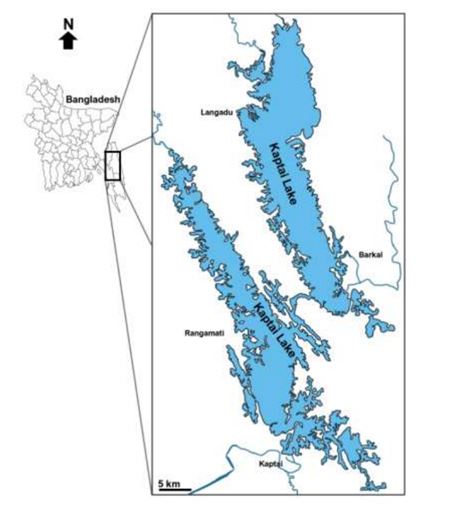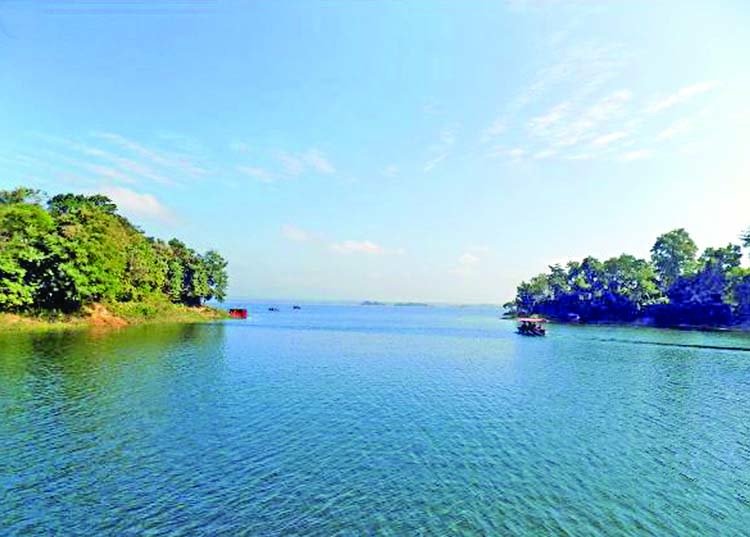Kaptai Lake
Kaptai Lake is the largest man-made freshwater body in Bangladesh. Though created primarily for hydroelectric power generation, it contributes to the production of a significant quantity of freshwater fish, navigation, flood control, agriculture, etc.
Location
The reservoir was created by damming the river Karnafuli near Kaptai town in the Chittagong Hill tracts (latitude 22° 09 N and longitude 92° 17E). The lake is confined within the hill district of Rangamati and embraces the upazilas of Rangamati Sadar, Kaptai, Nannerchar, Langadu, Baghaichhari, Barkal, Juraichhari, and Belaichhari.
Geography of the lake
- Kaptai Lake, shaped like an ‘H’, has two arms connected by a narrow gorge near Shubalong. The right arm, Kasalong, is fed by the Mayni and Kasalong streams, while the left arm, Rangamati-Kaptai, is fed by the Chengi and Rinkhyong streams. The Karnafuli forms three loops at Rangamati, Dhuliachhari, and Kaptai. The Rangamati and Dhuliachhari loops are now under an earth-filled dam reservoir. Kaptai Lake has flooded the middle-Karnafuli valley and lower reaches of the Chengi, Kasalong, and Rinkhyong rivers, with an irregular shoreline and basin.
- Kaptai Lake is primarily composed of yellowish brown, fine to medium-grained sandstone with alternating shale and silty shale (Tipam Sandstone Formation) and massive to cross-bedded sandstone with quartz granules, pebbles, clay galls, and well-preserved leaf impressions (Dupi Tila Formation). However, the lake around Shubalong and Barkal mainly comprises the Bhuban formation. The removal of protective vegetation exposes these rocks to monsoon rains, causing erosion and landslides. The loose rock material is washed down slopes and carried by rivers, causing the lake to rapidly silt up.

Figure 1: Location of Kaptai Lake (Salehin et al., 2022)
History
Kaptai Lake was created by damming the river Karnafuli in 1961. The Kaptai Dam was built in the 1950s to provide electricity. Construction started in 1957 with help from the United States. When the dam was completed, water started filling up behind it, creating Kaptai Lake. And covered about 655 square kilometers of land, which included farms, homes, and forests.
It is one of the largest reservoirs in southeast Asia. Although the lake was created primarily for hydro-electric power generation, it has also paved the way for substantial contribution to the national economy through freshwater fish production, navigation, irrigation and flood control.
Importance
The lake has not only generated hydroelectricity but also created a diverse and long waterway, making it easier to exploit forest resources. It has become a popular tourist attraction and significantly contributes to agriculture and fisheries development. The lake’s water level is maintained at different heights, allowing for an automatic irrigation system on its shores. The lakeshores are fertile, and people practice controlled farming on 6,075 ha of land through leasehold agreements with the local government.
Fisheries Resources
- The lake, estimated to have a 90-year lifespan, serves as a valuable reservoir for hatchery and fish production, meeting local demand and supplying Dhaka and other parts of the country.
- A total of 84 species of fishes, which consists of 75 finfish and 9 shellfish were identified during the study period. Among 75 finfish, 65 were indigenous freshwater fish species, 10 exotic species.
The most abundant freshwater fish species were Catla catla, Labeo rohita, Clarias batrachus, Cirrhinus cirrhosus, Channa punctatus. A total 20 species were threatened according to IUCN red list of Bangladesh including 7 vulnerable, 10 endangered and 3 critically endangered species out of 54 threatened fishes in fresh waters of Bangladesh. Ten exotic fish species (Hypophthalmicthys molitrix, Ctenopharyngo donidella, Cyprinus carpio, Puntius gonionotus, Oreochromis niloticus, Oreochromis mossambicus, Pangasius hypopthalmus, Mylopharyngodon piceus, Aristichthys nobilis and Clarias gariepinus) were found in Kaptai lake during the study period (Basak et al., 2016).

Figure 2: Kaptai Lake (dailyasianage)
For more details about the biodiversity of Kaptai Lake follow the following references:
- An overview on hydro-biology and management of Kaptai Lake Fisheries, Bangladesh
- Fish Diversity of Kaptai Lake in a Area to Rangamati Hill District
- Kaptai Lake and fisheries: Gears, species and marketing channel with management practices
Fish biodiversity of Kaptai lake is decreasing day by day due to habitat degradation and different manmade causes. Proper conservation measures should be taken to protect the threatened fish species from extinction.
References
- Basak SS, Basher MA, Saha AK, Roy NC (2016) Fish Diversity of Kaptai Lake in a area to Rangamati Hill District. J. Sylhet Agric. Univ, 3, 233-243
- Basak SS, Basher MA, Saha AK, Roy NC (2016) Fish Diversity of Kaptai Lake in a area to Rangamati Hill District. J. Sylhet Agric. Univ, 3, 233-243
- Kabir MTH, Rahman MA, Chowdhury P, Haque SM, Miah MI (2020) Kaptai Lake and fisheries: Gears, species and marketing channel with management practices. J. Entomol. Zool. Stud, 8, 19-25
- Lima RA, Ali A, Rahman MK, Islam MS, Moniruzzaman MD, Tamanna TA (2023). An overview on hydro-biology and management of Kaptai Lake Fisheries, Bangladesh. International Journal of Aquaculture and Fishery Sciences, 9(3), 029-039
- Lima RA, Ali A, Rahman MK, Islam MS, Moniruzzaman MD, Tamanna TA (2023). An overview on hydro-biology and management of Kaptai Lake Fisheries, Bangladesh. International Journal of Aquaculture and Fishery Sciences, 9(3), 029-039
- Rahman MM, Rahman MM, Huda MK (2017) Seasonal variations of chemical properties of water of the Kaptai lake, Rangamati, Bangladesh. Jahangirnagar University Journal of Biological Sciences, 6(2), 11-17
- Shalehin MS, Parvez MT, Lucas MC, Galib SM (2022) A case study of illegal fishing causes during seasonal fishery closure in Kaptai Lake, Bangladesh. Fisheries Management and Ecology, 29(5), 542-551
- Suman K H, Hossain MS, Salam MA, Rupok QSS, Haque MN (2021) Production trends, and challenges for biodiversity conservation and sustainable fisheries management of Kaptai Lake, the largest reservoir in Bangladesh. Asian Fisheries Science, 34(2)